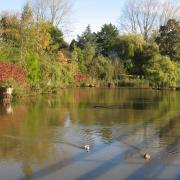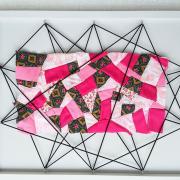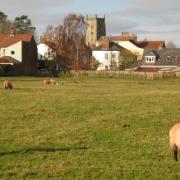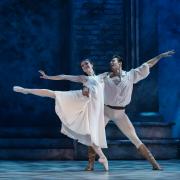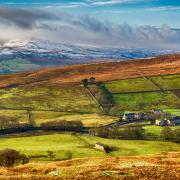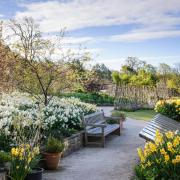Behind the scenes at a Barnsley theatre lit by 40 miners’ lamps

South Yorkshire’s coal mining industry might have been snuffed out but its memory lingers on in the beautiful glow of the theatre lights at The Lamproom in Barnsley. As the house lights dim in the 20-year-old Westgate theatre, the last to fade into darkness are 40 original miners’ lamps, each representing a Barnsley colliery. Then, as the interval begins and thoughts turn to ice cream and, perhaps, a swift pint, the first glow once again emerges from the miners’ lamps as they light the way, as they once did at the likes of North Gawber, Kendal Drift, Darton and Ferrymoor.
Theatre founder John Kelly, father of actress Katherine Kelly who found fame as Becky McDonald in Coronation Street, always envisioned The Lamproom’s 186-seat auditorium peppered with light from miners’ lamps, reflecting his own history and that of thousands of other South Yorkshire families.
His dream became a reality this autumn when a request via the local paper for original lamps and checks (the small metal disks used to count the men down the pit and, more importantly, count them back up again) attracted dozens of donations from men who had spent their working life underground and from families giving in memory of deceased pitmen.
‘We invited everyone who’d donated a lamp to come in and see it in situ with its plaque,’ said theatre manager Ruth Pearson. ‘It was very emotional for some of them. There were a fair few with a tear in their eye.

‘The lamps now light the auditorium. They’re the last lights to go out and the first ones to come back on again. It’s a beautiful sight and very, very Barnsley.’
The Lamproom was originally a Georgian Methodist chapel, one of the many that John Wesley is said to have preached at. It remained a church until the 1950s, when it became the base for Barnsley Boys’ Club, where youngsters would gather to box, play badminton and generally keep out of mischief. It was an important part of town life for generations of boys but, by the 1990s, its popularity had begun to fade and the building was put on the market.
At about the same time, Barnsley Council decided to mothball the town’s 800-seat theatre – The Civic – because of lack of funding, leaving a gaping hole at its cultural heart.
John Kelly had been involved in amateur and professional theatre for years and was worried that Barnsley’s strong contingent of operatic, drama and musical theatre groups would gradually disperse if they had nowhere to perform.

‘He just thought a town of 250,000 people should have its own theatre,’ said Ruth. ‘So, he decided to start one.’
He originally set his sights on the old Theatre Royal, which had been turned into a bingo hall some years earlier. But a gentleman’s agreement with the owner turned sour when it was sold to a third party as a nightclub development.
That’s when John’s thoughts turned to the old boys’ club, a dilapidated, leaky but solid and centrally-located building that, with a lot of money, hard work and passion, offered exciting possibilities.
He gathered together a group of people with a host of useful skills – including Ruth, who he had met when she was the manager’s secretary at Barnsley Football Club – and invited them to form Barnsley Theatre Trust.
‘He purposefully held our first meeting around a rickety trestle table in the freezing auditorium,’ said Ruth. ‘It was in a shocking state. We had to shuffle down a plank of wood to get in and a big patch of the floor had been burned away, presumably by homeless people trying to stay warm.
‘It was so cold, I had to make notes wearing mittens, but it gave us a realistic picture of the task ahead of us. From then on, we knew it would be a massive effort.’
With the help of hundreds of volunteers, the theatre opened a year later, in April 1999, with a gala evening featuring two local opera singers followed by its first play, The Crucible.
‘We begged, borrowed and stole – sorry, but you’ve got to do what you’ve got to do – whatever we needed to open within the year,’ said Ruth. ‘We were amazed and humbled by the number of people who turned up to help. They really put the hours in.
‘I remember on the gala evening one of the local councillors said, “these seats are just like the ones we used to have at The Civic”, not knowing that they were the ones from The Civic. They were just left to rot so we rescued them.’
Over the last two decades, The Lamproom has evolved into a theatre-maker as well as a theatre-stager, launching its own youth, theatre and musical theatre ensembles, which have built up an enviable reputation for quality shows while raising money for the upkeep of their theatrical home.
The Friends of The Lamproom, its fundraising and volunteer group, also work tirelessly to support the theatre’s three full-time and five part-time staff and ensure that jobs get ticked off the endless to-do list of maintenance and improvement.
‘They help us to live within our means,’ said Ruth. ‘It’s important for us to keep improving our offering, but we only do what we can afford, when we can afford it.
‘We have to paddle our own canoe financially as don’t get any Arts Council funding. But that’s actually served us quite well over the years because you can’t miss what you’ve never had.’
The next big project on The Lamproom’s agenda is the bar area, which is currently adorned with playbills and decorated plates (created by Katherine Kelly’s maternal grandmother) marking every show it’s staged.
‘We haven’t quite decided what we’re doing in here yet, but we’ll get there eventually,’ said Ruth, as we surveyed the spacious but undeniably worn out bar. ‘Then we’ll think about a new stage. And the box office needs looking at. And before you know it, we’ll be reupholstering the seats again.’
It’s safe to say then that The Lamproom is less of a one act wonder and more of an epic production. What’s also clear, however, is that this is a show that will run and run, its house lights casting a creative glow on Barnsley’s past, present and future.




